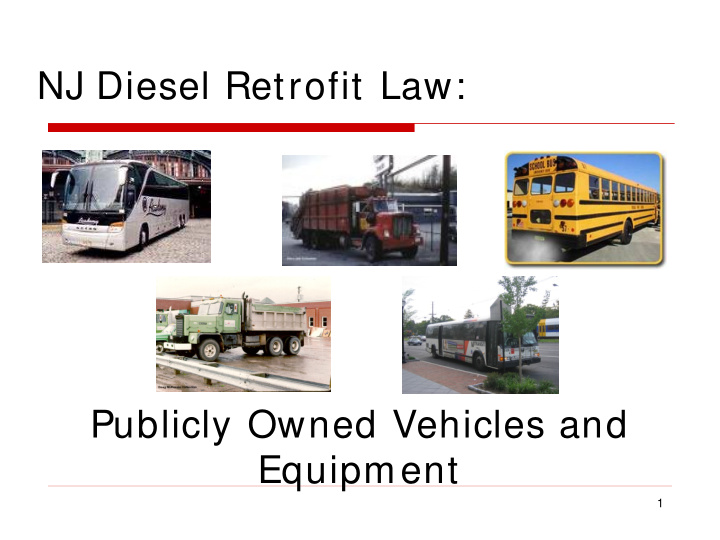



NJ Diesel Retrofit Law: Publicly Owned Vehicles and Equipment 1
Diesel Retrofit Overview Reduces diesel emissions and the health impacts associated with diesel exhaust Components of the rules: closed crankcase ventilation systems for school buses tailpipe retrofits (BART) for regulated diesel vehicles Reimbursement of purchase and installation costs (Corp Business Tax) 2
Intent of the Diesel Retrofit Law Reduce 150 tons of diesel particulate matter from the air every year. Targets vehicles with operational presence in neighborhoods and have potential to directly expose citizens to diesel particulate matter. Prioritizes PM reductions of in urban areas = = > Cleaner emissions, lower noise 3
Diesel Exhaust Classified carcinogen - World Health Org Causes Asthma and Respiratory Distress Cardiopulmonary diseases Premature deaths 4
GOAL: All areas of the state under the benchmark
Retrofit Law Components Regulated vehicles must be retrofit with PM Controls meeting BART standard Compliance burden on vehicle owner Submit Inventory / Cost Estimate public utility vehicles & equipment due 9/ 8/ 2011 Schedule installations & maintain devices Direct Reimbursement (state contract) Authorized installers Retrofit warranty 6
Completed Retrofits… School Bus CCVS* 7,200 School Bus BART* 205 Solid Waste BART* 1,250 NJTransit BART* 1,300 Commercial Bus BART* 1,770 Public Vehicles & Equipment* Approved~ 1,798 Retrofit~ 309 Voluntary Offroad Retrofits- 225 * = Regulated in Diesel Retrofit Law
Retrofit Funding Corporate Business Tax Component Expires 1/ 1/ 2016 Approved $65 million cost estimates Reimbursed $43 million 8
Diesel Retrofits- Public Fleet Regulated Vehicles " Regulated off-road diesel equipm ent " means any model year 1996 or newer off-road diesel equipment operated in the State that is owned by the State or any political subdivision thereof, or a county or municipality, or any political subdivision thereof, and that is equipped with a more than 175 horsepower engine. Minimum 85% PM reduction " Regulated on-road diesel vehicle " means any on-road diesel vehicle registered in the State that is owned by the State or any political subdivision thereof, or a county or municipality, or any political subdivision thereof. Minimum 50% PM reduction No exemptions due to vehicle age Regulated Solid Waste Vehicles defined separately, due 6/ 2008 9
Retrofit Law- General exemptions 2007 & newer model year on-road engines Engines meeting the 0.01 g/ bhp-hr PM standard Off-road engines meeting 0.015 g/ bhp-hr PM standard (~ 2011 to 2014 phase in) First aid, emergency, ambulance, rescue & fire Dedicated equipment, not plow trucks Dedicated Agricultural Vehicles 10
Compliance Tools Guidance Document (Recommended reading) State Contract - Authorized Installers Submittal through DEPOnline Workshops www.Stopthesoot.org website List server messaging system Program Staff 11
Retrofit Devices Diesel Particulate Filters and Catalytic Converters DPFs - $6,000-18,000 – > 85% PM redux DOCs- $1,500- 3,500 - 25% PM redux Meet definition of BART USEPA or CARB verified diesel retrofit emission control and reductions (% ) 12
Reimbursement Covered cost BART & ancillary items for turnkey Installation labor Not covered Consumable items such as replacement filters Facility upgrades electrical services for regeneration systems Remedial repairs necessary to retrofit vehicle Existing damage, wear and tear, or modifications precluding installation of BART. Non-contract installations unless under approved grant. 13
Basic Program Steps 1. Owner identifies Regulated Vehicles 2. Determine appropriate BART & Installer 3. Submit Inventory/ cost estimate form includes inventory of all diesels support docs for exempts/ lower BARTs 4. DEP review/ approve cost estimates 5. Installation 6. Submittals and Recordkeeping 7. One-Time Compliance Inspections 14
Determining BART Owner Research Manufacturer and CARB/ USEPA specifications Engine Model Year Duty Cycle Vehicle/ Equipment Type EGR/ non-EGR Examination and Observations by Authorized Installer Exhaust Temperature Profiles Backpressure Monitoring Sizing Concerns 15
16
Why Collect This Information? Retrofits meet law Internal controls/ prevent fraud Pre-populate Compliance Form Satisfy procurement process Determine funds availability = = > DEP review & approval Letter with due dates for installations 17
Compliance Form Owner downloads-prints & signs after install Enter “retrofit device family name” by hand Send copy to DEP, original with vehicle Form due to DEP 5 days after retrofit installation is complete (Owner signature & device family name) Installation verified at next emissions inspection Inspector signs compliance form Owner sends copy of signed form to DEP Form due 30 days after inspection Must have Inspector signature Original stays with vehicle 18
19
Tailpipe technologies DOC (diesel oxidation catalyst) DPF (diesel particulate filter) Mostly muffler replacements + ancillary 20
Diesel Oxidation Catalyst (DOC) BART Level 1 Devices Have a PM reduction capability of 25% Uses a catalytically induced reaction that converts PM, CO and Hydrocarbons to CO 2 and H 2 O (usually platinum catalyst) Does not use a filter 21
Diesel Particulate Filter (DPF) BART Level 3 Devices – 85% PM reduction Uses a filter to “trap” PM particles in the exhaust Passive Uses a catalyst to reduce PM ignition temperature and PM is incinerated using exhaust heat Active Uses an external source of heat to incinerate the PM trapped in the filter Cooler/ low-power duty cycles or varied use Dual regeneration filters have both a passive and active system 22
Retrofit Device Label Manufacturer Information Serial Number Family Name 23
BART Warranty & Installation Requirements Retrofit, installation and engine damage Must repair any damage to vehicle caused by normal use of retrofit Vehicle has to be in good working order High oil consumption is bad for BARTs Must maintain BART retrofit device as per manufacturer specifications On-Road = 5 years or mileage cutoff Off-Road = 5 years or 4200 hours 24
Retrofit Maintenance Owners- Retrofit Maintenance ash removal, filter cleaning & regenerations Proper fuels (ULSF, B20) No fryer oil Repair damage Poor Vehicle maintenance impacts BART Excessive idling effects BART maintenance On vehicle to end-of-life ( N.J.A.C. 7: 27-14.3) 25
Support Information Website at http: / / www.stopthesoot.org (609) 292-7953 26
Recommend
More recommend